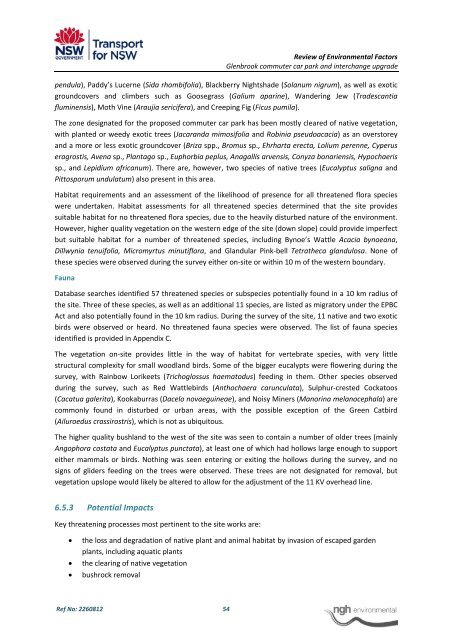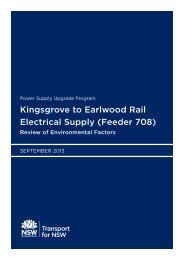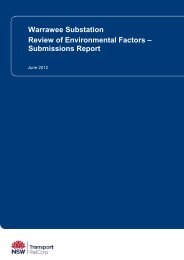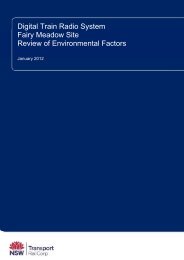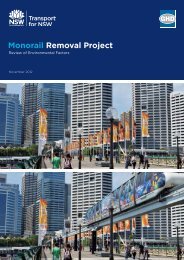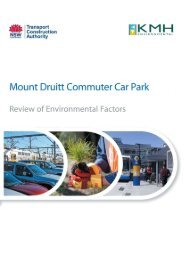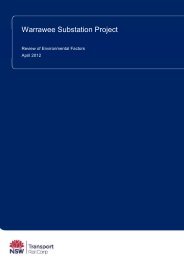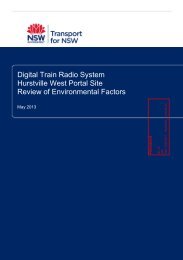Glenbrook Sation REF (pdf 3.15MB) - Transport for NSW - NSW ...
Glenbrook Sation REF (pdf 3.15MB) - Transport for NSW - NSW ...
Glenbrook Sation REF (pdf 3.15MB) - Transport for NSW - NSW ...
- No tags were found...
Create successful ePaper yourself
Turn your PDF publications into a flip-book with our unique Google optimized e-Paper software.
Review of Environmental Factors<strong>Glenbrook</strong> commuter car park and interchange upgradependula), Paddy’s Lucerne (Sida rhombifolia), Blackberry Nightshade (Solanum nigrum), as well as exoticgroundcovers and climbers such as Goosegrass (Galium aparine), Wandering Jew (Tradescantiafluminensis), Moth Vine (Araujia sericifera), and Creeping Fig (Ficus pumila).The zone designated <strong>for</strong> the proposed commuter car park has been mostly cleared of native vegetation,with planted or weedy exotic trees (Jacaranda mimosifolia and Robinia pseudoacacia) as an overstoreyand a more or less exotic groundcover (Briza spp., Bromus sp., Ehrharta erecta, Lolium perenne, Cyperuseragrostis, Avena sp., Plantago sp., Euphorbia peplus, Anagallis arvensis, Conyza bonariensis, Hypochaerissp., and Lepidium africanum). There are, however, two species of native trees (Eucalyptus saligna andPittosporum undulatum) also present in this area.Habitat requirements and an assessment of the likelihood of presence <strong>for</strong> all threatened flora specieswere undertaken. Habitat assessments <strong>for</strong> all threatened species determined that the site providessuitable habitat <strong>for</strong> no threatened flora species, due to the heavily disturbed nature of the environment.However, higher quality vegetation on the western edge of the site (down slope) could provide imperfectbut suitable habitat <strong>for</strong> a number of threatened species, including Bynoe’s Wattle Acacia bynoeana,Dillwynia tenuifolia, Micromyrtus minutiflora, and Glandular Pink‐bell Tetratheca glandulosa. None ofthese species were observed during the survey either on‐site or within 10 m of the western boundary.FaunaDatabase searches identified 57 threatened species or subspecies potentially found in a 10 km radius ofthe site. Three of these species, as well as an additional 11 species, are listed as migratory under the EPBCAct and also potentially found in the 10 km radius. During the survey of the site, 11 native and two exoticbirds were observed or heard. No threatened fauna species were observed. The list of fauna speciesidentified is provided in Appendix C.The vegetation on‐site provides little in the way of habitat <strong>for</strong> vertebrate species, with very littlestructural complexity <strong>for</strong> small woodland birds. Some of the bigger eucalypts were flowering during thesurvey, with Rainbow Lorikeets (Trichoglossus haematodus) feeding in them. Other species observedduring the survey, such as Red Wattlebirds (Anthochaera carunculata), Sulphur‐crested Cockatoos(Cacatua galerita), Kookaburras (Dacelo novaeguineae), and Noisy Miners (Manorina melanocephala) arecommonly found in disturbed or urban areas, with the possible exception of the Green Catbird(Ailuroedus crassirostris), which is not as ubiquitous.The higher quality bushland to the west of the site was seen to contain a number of older trees (mainlyAngophora costata and Eucalyptus punctata), at least one of which had hollows large enough to supporteither mammals or birds. Nothing was seen entering or exiting the hollows during the survey, and nosigns of gliders feeding on the trees were observed. These trees are not designated <strong>for</strong> removal, butvegetation upslope would likely be altered to allow <strong>for</strong> the adjustment of the 11 KV overhead line.6.5.3 Potential ImpactsKey threatening processes most pertinent to the site works are:• the loss and degradation of native plant and animal habitat by invasion of escaped gardenplants, including aquatic plants• the clearing of native vegetation• bushrock removalRef No: 2260812 54


